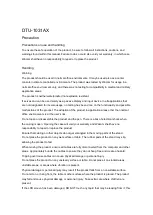
114
Safety
(Body measurements differ among phone and tablet models, depending
upon available accessories and FCC requirements).
While there may be differences between SAR levels of various devices and
at various positions, they all meet the government requirement for safe
exposure.
The FCC has granted an Equipment Authorization for this model device
with all reported SAR levels evaluated as in compliance with the FCC RF
emission guidelines. SAR information on this model device is on file with
the FCC and can be found under the Display Grant section of http://www.
fcc.gov/oet/fccid after searching on FCC ID ZNFVK815. Additional
information on Specific Absorption Rates (SAR) can be found on the
Cellular Telecommunications Industry Association (CTIA) website at http://
www.ctia.org/.
* In the United States and Canada, the SAR limit for mobile device used by
the public is 1.6 watts/kg (W/kg) averaged over one gram of tissue. The
standard incorporates a substantial margin of safety to give additional
protection for the public and to account for any variations in
measurements.
Caution:
Avoid potential hearing loss
Prolonged exposure to loud sounds (including music) is the most common
cause of preventable hearing loss. Some scientific research suggests that
using portable audio devices, such as portable music players and cellular
telephones, at high volume settings for long durations may lead to
permanent noise-induced hearing loss. This includes the use of
headphones (including headsets, earbuds and Bluetooth
®
or other wireless
devices). Exposure to very loud sound has also been associated in some
studies with tinnitus (a ringing in the ear), hypersensitivity to sound, and
distorted hearing. Individual susceptibility to noise-induced hearing loss and
other potential hearing problems varies. The amount of sound produced by
a portable audio device varies depending on the nature of the sound, the
Summary of Contents for G PADF 8.0 PLUS
Page 1: ...ENGLISH MFL69137101 1 0 USER GUIDE ...
Page 140: ......
















































